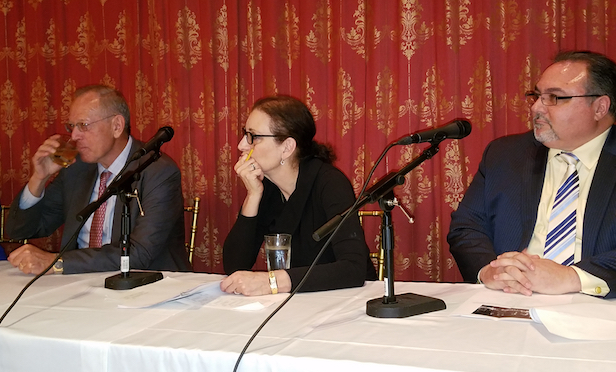
NEW YORK CITY—In January, SoftBank led an $865 million investment in Katerra. The upstart company, which plans to transform construction by creating prefab, modular homes in factories, is now valued at $3 billion.
Buildings Constructed in Factories—An Industry Disrupter?
Jeffrey E. Levine, chairman of Douglaston Development, LLC and Levine Builders, visited Katerra's factory in Glendale, AZ. He described it as a “200,000 square-foot industrial warehouse they purchased on the cheap and fit up with a couple of conveyor belts.”
“It was frightening to me. I didn't see as much as a pneumatic tool,” said Levine. “But theoretically, they are going to be the people who are going to solve the housing problem in California.”
Levine said he could see this as a solution for low-rise, low-density affordable housing. But he did not see stacking up units as the future for high-rises in dense, urban areas like New York City.
Anthony Rinaldi, the president of the Rinaldi Group agreed, saying modular mass construction works in rural areas, lacking in labor force. “Four, five, six stories with cookie cutters, that becomes something easy to manufacture, should you have a plant.”
However, Rinaldi is building what has been marketed as “the world's tallest modular hotel,” the CitizenM, a 22-story building located at 189 Bowery. All of the rooms will arrive pre-assembled from Poland. This is expected to not only save on costs but also cut construction time in half.
Levine and Rinaldi joined John Catsimatidis, CEO and chair of Red Apple Group, Faith Hope Consolo, chairman of the retail group, Douglas Elliman Real Estate, and Donna Olshan, president of Olshan Realty, in a panel discussion moderated by Lou Katsos, president of Jekmar Associates, at an East Mediterranean Business Culture Alliance program in the Russian Tea Room. The talk was billed as a “fun, unscripted discussion on the state of development, design and construction in New York and beyond.”
With prefab housing not ruffling any feathers as an immediate real estate industry game changer, what was on the minds of these industry veterans?
The Cost of Construction
Developers say building is economically driven contrasted with architects who may find it art or design-driven. However, developers still want a “wow factor”—while watching the bottom line. Born on a small, Greek Island surrounded by water, Catsimatidis is developing 21-story twin towers with 440 units on Coney Island. Every apartment will have a terrace with a beach view.

Catsimatidis said constructing high-rise condominiums in Miami runs about $150 to $175 per square foot. He compared this to New York, where he noted it can run anywhere from $500 to $1,000 per square foot.
Rinaldi said salaries had become “crazy, ludicrous, absolutely insane,” claiming there are operating engineers making over $400,000. “I paid an operating engineer a million dollars on a project, one man to operate a crawler crane and it wasn't even a tower crane,” he said. Rinaldi noted if ever there was a time to go to trade school, a skilled craftsman today can make a hefty salary. Carpenters, in the union and not, can earn $250,000 a year, according to Rinaldi.
Levine pointed out awhile back non-union work could be 20% or in some cases 25% cheaper than union labor. But non-union workers' prices went up as they filled a demand, shrinking the differential to as little as 15% to 10% for high-end residential work. However, with lower level, “stick and brick” work in the Bronx or Staten Island, there will still be a gap of at least 20% between non-union and union pay.
Katsos said nonetheless with some trades including mechanical and electrical work, it is most effective to go to union contractors. With some large HVAC projects, non-union workers cannot do the job. “Good work costs what good work cost. The gap between union and non-union is very small,” said Katsos.
Problems Facing the Industry
“It's screaming. The market is overpriced and to get it to move, the sellers have to adjust,” said Olshan. Developers get money from the bank, hire a designer architect, and put up a building, according to Olshan. But selling is more complicated and developers need to be more strategic, she said.
“If you're in the Olympics, the person who is the fastest in the pool wins, right? In real estate, the pool is your sector and whoever is priced the best is the person who is going to win,” said Olshan. She added buildings get built, stay on the marketplace longer, and that's a problem—and that's where the industry is now.

Consolo added for retail with new developments, there are certain magnets: Hudson Yards, the Brookfield Center, the Seaport, the World Financial Center. But all of these choices confuse retailers who wonder whether they should go East Side, West Side, Downtown or where they'll get an underrated deal?
What to Do? Be Smarter.
A retail landlord came to Consolo with 15 buildings and 150 stores, all in Harlem. After three brokers and five years, none had been leased. She gathered a team and looked at the property. “We're taking this portfolio. We're going to put one guy on it. I'm going to run it and we're going to make a campaign,” Consolo told the property management. She created a campaign with her name, “Have Faith in Harlem.” (She received some calls with people asking, “Are you opening a church?”)
Yet the team leased every single store. More importantly, Consolo forged business connections and now sits on the board of directors of the Greater Harlem Chamber of Commerce. But she warns these assignments are not for everyone because they are not successfully completed overnight. For today's competitive market especially in retail, Consolo advised, “We have to work smarter, more carefully, know who's expanding and try to figure out the trends beforehand.”
© 2025 ALM Global, LLC, All Rights Reserved. Request academic re-use from www.copyright.com. All other uses, submit a request to [email protected]. For more information visit Asset & Logo Licensing.








